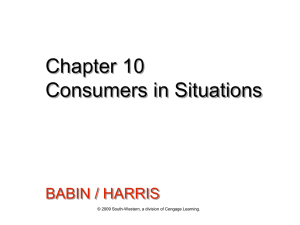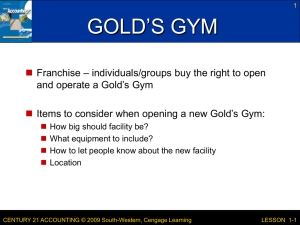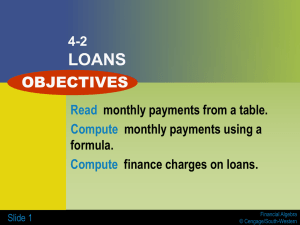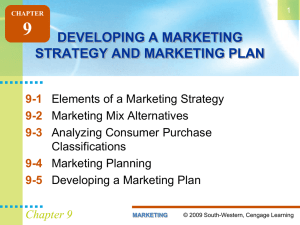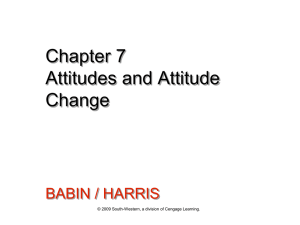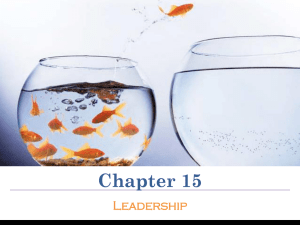Chapter 6
advertisement
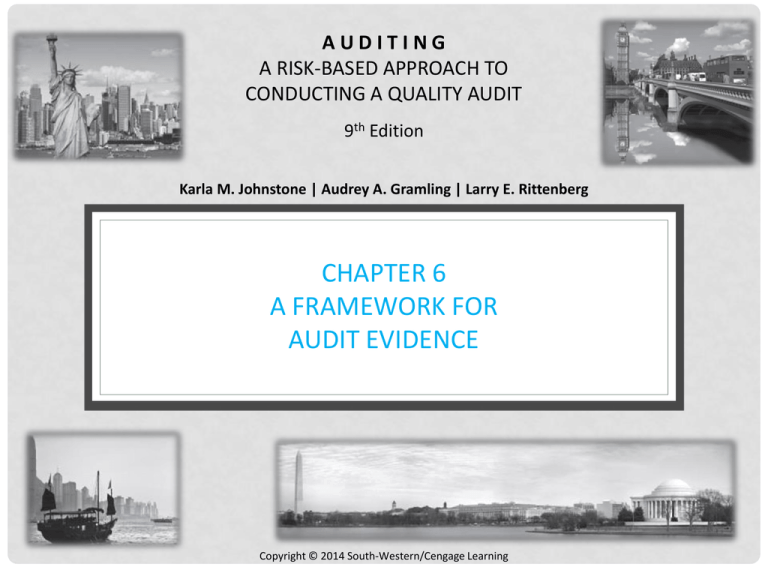
AUDITING A RISK-BASED APPROACH TO CONDUCTING A QUALITY AUDIT 9th Edition Karla M. Johnstone | Audrey A. Gramling | Larry E. Rittenberg CHAPTER 6 A FRAMEWORK FOR AUDIT EVIDENCE Copyright © 2014 South-Western/Cengage Learning LEARNING OBJECTIVES 1. 2. 3. 4. Discuss the importance of the evidence concepts of appropriateness and sufficiency Identify factors affecting the appropriateness of audit evidence Make professional judgments about the type and timing of audit procedures to use to obtain audit evidence Discuss the use of, and apply, substantive analytical procedures Copyright © 2014 South-Western/Cengage Learning 6-2 LEARNING OBJECTIVES 5. 6. 7. 8. Identify factors affecting the sufficiency of audit evidence Identify issues related to audit evidence needed for accounts involving management estimates Determine situations requiring the auditor to use a specialist/expert and describe the auditor’s responsibilities related to that specialist/expert Describe the evidence needs for related-party transactions Copyright © 2014 South-Western/Cengage Learning 6-3 LEARNING OBJECTIVES 9. 10. 11. Describe the characteristics of quality audit documentation Explain the nature, design, and purposes of audit programs Apply the frameworks for professional decision making and ethical decision making to issues involving audit evidence Copyright © 2014 South-Western/Cengage Learning 6-4 THE AUDIT OPINION FORMULATION PROCESS Copyright © 2014 South-Western/Cengage Learning 6-5 PROFESSIONAL JUDGMENT IN CONTEXT - EVIDENCERELATED FINDINGS IN PCAOB INSPECTION REPORTS • Some excerpts describe following types of audit deficiencies related to evidence • Failure in sufficiently testing inventory • Failure in sufficiently testing valuation of accounts receivable and net revenue • Failure in obtaining sufficient audit evidence to support its opinion on effectiveness of internal control over financial reporting (ICFR) • Failure in sufficiently testing revenue Copyright © 2014 South-Western/Cengage Learning 6-6 PROFESSIONAL JUDGMENT IN CONTEXT - EVIDENCERELATED FINDINGS IN PCAOB INSPECTION REPORTS • What is sufficient appropriate evidence, and how does it differ across clients? (LO 1, 2, 5) • What are substantive analytical procedures, and when is evidence from these procedures appropriate? (LO 4) • What are the unique evidence challenges for accounts such as allowance for doubtful accounts that are based on management estimates? (LO 6) Copyright © 2014 South-Western/Cengage Learning 6-7 PROFESSIONAL JUDGMENT IN CONTEXT - EVIDENCERELATED FINDINGS IN PCAOB INSPECTION REPORTS • How could the use of a standardized audit program lead to some of the problems identified in the PCAOB Releases introduced earlier? (LO 10) Copyright © 2014 South-Western/Cengage Learning 6-8 LEARNING OBJECTIVE 1 DISCUSS THE IMPORTANCE OF THE EVIDENCE CONCEPTS OF APPROPRIATENESS AND SUFFICIENCY Copyright © 2014 South-Western/Cengage Learning AUDIT EVIDENCE DEFINED BY AS 15 • Information that is used by the auditor in arriving at conclusions on which auditor’s opinion is based • Consists of information that either supports or contradicts management’s assertions regarding: • Financial statements • Internal control over financial reporting Copyright © 2014 South-Western/Cengage Learning 6-10 EXHIBIT 6.1 - INTERRELATIONSHIP OF RISK AND EVIDENCE APPROPRIATENESS AND SUFFICIENCY Copyright © 2014 South-Western/Cengage Learning 6-11 LEARNING OBJECTIVE 2 IDENTIFY FACTORS AFFECTING THE APPROPRIATENESS OF AUDIT EVIDENCE Copyright © 2014 South-Western/Cengage Learning APPROPRIATENESS OF AUDIT EVIDENCE • Measure of quality of audit evidence that includes: • Relevance: Evidence that provides insight on the validity of the assertion being tested • Reliability: Measure of quality of underlying evidence influenced by: • Risk • Potential management bias • Quality of internal control system Copyright © 2014 South-Western/Cengage Learning 6-13 RELEVANCE OF AUDIT EVIDENCE • Affected by the following factors • Purpose of procedure being performed • Direction of testing • Specific procedure or set of procedures being performed Copyright © 2014 South-Western/Cengage Learning 6-14 AUDITING IN PRACTICE - IS THE EVIDENCE RELEVANT TO THE ASSERTION BEING TESTED? • Guard against unwarranted inferences in gathering audit evidence • Example of inappropriate inference • Testing existence of client’s equipment by inspecting asset and concluding that asset exists and is properly valued • Evidence about existence of equipment does not provide relevant evidence that equipment is properly valued Copyright © 2014 South-Western/Cengage Learning 6-15 PURPOSE OF AN AUDIT PROCEDURE • Risk assessment - Identifies risks of material misstatement • Tests of controls - Evaluates effectiveness of controls in detecting and correcting, material misstatements • Substantive procedures - Provides direct evidence about presence of material misstatements Copyright © 2014 South-Western/Cengage Learning 6-16 DIRECTIONAL TESTING • Approach to test account balances that considers: • Type of misstatement likely to occur • Corresponding evidence provided by other accounts that have been tested • Assets and expenses for overstatement and liabilities and revenues for understatement because: • There is major risks of misstatements • Tests of other accounts provide evidence of possible misstatements in other direction Copyright © 2014 South-Western/Cengage Learning 6-17 EXHIBIT 6.2 - ILLUSTRATION OF TESTING FOR EXISTENCE AND COMPLETENESS Copyright © 2014 South-Western/Cengage Learning 6-18 TESTING FOR EXISTENCE • Vouching: Taking a sample of recorded transactions and obtaining original source documents supporting recorded transaction • Addresses overstatement • Provides evidence on the assertion that recorded transactions are valid Copyright © 2014 South-Western/Cengage Learning 6-19 TESTING FOR COMPLETENESS • Tracing: Taking a sample of original source documents and ensuring that transactions related to source documents have been recorded in appropriate journal and general ledger • Called reprocessing • Addresses understatement Copyright © 2014 South-Western/Cengage Learning 6-20 TYPE OF PROCEDURE • Specific audit procedure required to provide audit evidence that is relevant to certain assertions, but not others • Example - Walking through client’s warehouse to inspect inventory would result in evidence related to existence of inventory, but not to valuation Copyright © 2014 South-Western/Cengage Learning 6-21 DIRECT AND INDIRECT EVIDENCE • Direct • Relevant to a specific assertion • Requires only one inference to reach a conclusion about the assertion being tested • Indirect • Not directly relevant to a specific assertion • Insufficient, when high risk of material misstatement exists • Requires a linkage of inferences to provide assurance Copyright © 2014 South-Western/Cengage Learning 6-22 RELIABILITY OF AUDIT EVIDENCE • Judged by its ability to provide convincing evidence related to the audit objective being evaluated • According to the text of ISA 500 (A31) • The reliability of the audit evidence is influenced by: • Its source and its nature • Circumstances under which it is obtained • Includes the controls for preparation and maintenance • Generalizations about reliability of various kinds of audit evidence are subject to important exceptions Copyright © 2014 South-Western/Cengage Learning 6-23 GENERALIZATIONS ESTABLISHED BY IAASB, IN ISA 500 Copyright © 2014 South-Western/Cengage Learning 6-24 INTERNAL DOCUMENTATION • Reliability varies depending on: • Effectiveness of internal controls • Management motivation to misstate individual accounts • Formality of documentation • Example - Acknowledgment of its validity by parties independent of the accounting function • Independence of those preparing documentation from those recording transactions Copyright © 2014 South-Western/Cengage Learning 6-25 EXTERNAL DOCUMENTATION • Considered highly reliable • Reliability varies depending on whether the documentation: • Was prepared by a knowledgeable and independent outside party • Is received directly by auditor • Is directed to the client Copyright © 2014 South-Western/Cengage Learning 6-26 TYPES OF INTERNAL AND EXTERNAL DOCUMENTS • Internal • • • • Legal documents Business documents Accounting documents Other planning and control documents • External • Business documents • Third-party documents • General business information Copyright © 2014 South-Western/Cengage Learning 6-27 EVIDENCE FROM A MANAGEMENT’S SPECIALIST • Management’s specialist • Individual or organization possessing expertise in a field other than accounting or auditing • Assists in preparing financial statements • Consider the following factors • Competence, capabilities, and objectivity • Work performed • Appropriateness of his or her work as audit evidence for relevant assertion Copyright © 2014 South-Western/Cengage Learning 6-28 LEARNING OBJECTIVE 3 MAKE PROFESSIONAL JUDGMENTS ABOUT THE TYPE AND TIMING OF AUDIT PROCEDURES TO USE TO OBTAIN AUDIT EVIDENCE Copyright © 2014 South-Western/Cengage Learning EXHIBIT 6.5 - TYPE OF AUDIT PROCEDURES Copyright © 2014 South-Western/Cengage Learning 6-30 ACCOUNTING RECORDS • Initial accounting entries and supporting records • Include: • Evidence of internal controls over financial reporting, as well as supporting records • The general and subsidiary ledgers • Journal entries • Worksheets supporting cost allocations, computations, reconciliations, and disclosures Copyright © 2014 South-Western/Cengage Learning 6-31 CORROBORATING INFORMATION • Validates underlying accounting records • Includes the following evidence • • • • • • Minutes of meetings Confirmations from independent parties Industry data Inquiry Observation Inspection of documents Copyright © 2014 South-Western/Cengage Learning 6-32 AUDITING IN PRACTICE - THE PARMALAT CONFIRMATION FRAUD • Involved a large family-held Italian company that produced dairy products around the world • Company’s management committed a fraud that involved: • Taking cash from the business for family purposes, but not recording transactions in the books • Shifting monetary assets in and out of banks • Audit senior’s carelessness in mailing the bank confirmation provided a way for management to conceal the fraud Copyright © 2014 South-Western/Cengage Learning 6-33 EXHIBIT 6.6 - TYPES OF RECALCULATIONS PERFORMED BY AUDITOR Copyright © 2014 South-Western/Cengage Learning 6-34 EXHIBIT 6.7 - MANAGEMENT ASSERTIONS AND EXAMPLES OF RELATED AUDIT PROCEDURES Copyright © 2014 South-Western/Cengage Learning 6-35 ASSESSING THE CONSISTENCY OF EVIDENCE • Consider all sources of information and consistency of information • AS 15 requirement • Consider internal consistency of evidence gathered • Consider consistency of internal evidence generated with external evidence gathered • Expand evidence-gathering procedures for areas where results are inconsistent • Document conclusions based on evidence gathered Copyright © 2014 South-Western/Cengage Learning 6-36 COST–BENEFIT CONSIDERATIONS WHEN SELECTING AUDIT PROCEDURES • Should balance following objectives • Profitability • Managing risk • Each audit procedure takes time, effort, and ultimately money to perform • Rigorous audit procedures providing higher quality evidence are more costly to perform • Determining appropriate mix of evidence based on auditor’s professional judgment Copyright © 2014 South-Western/Cengage Learning 6-37 EXHIBIT 6.8 - COST OF AUDIT PROCEDURES AND EVIDENCE QUALITY Copyright © 2014 South-Western/Cengage Learning 6-38 TIMING OF PROCEDURES • At the balance sheet date • Interim date: Earlier than balance sheet date • After the balance sheet date • Decision based on: • • • • Assessment of risk associated with account Effectiveness of internal controls Nature of the account Availability of audit staff Copyright © 2014 South-Western/Cengage Learning 6-39 TIMING OF PROCEDURES • Performing procedures after year end may provide most convincing evidence • Performing procedures prior to the balance sheet date • Allows earlier completion of audit • Might require less overtime of the audit staff • Might meet management’s desire to distribute financial statements shortly after year end • May increase in risk of failing to detect material misstatements that occur between interim date and year end Copyright © 2014 South-Western/Cengage Learning 6-40 TIMING OF PROCEDURES • Roll-forward period: Period between the confirmation date and the balance sheet date • Cutoff period: Covers several days before and after client’s balance sheet date • Risk- Recording transactions in wrong period • Cutoff tests: Applied to transactions recorded during cutoff period • Provide evidence, as to whether transactions have been recorded in the proper record period Copyright © 2014 South-Western/Cengage Learning 6-41 TIMING OF PROCEDURES Copyright © 2014 South-Western/Cengage Learning 6-42 LEARNING OBJECTIVE 4 DISCUSS THE USE OF, AND APPLY, SUBSTANTIVE ANALYTICAL PROCEDURES Copyright © 2014 South-Western/Cengage Learning EXHIBIT 6.9 - ALTERNATIVE APPROACHES TO SUBSTANTIVE PROCEDURES Copyright © 2014 South-Western/Cengage Learning 6-44 CONSIDERATIONS IN PERFORMING SUBSTANTIVE ANALYTICAL PROCEDURES • Does the company have adequate internal controls over the account? • Is the risk of material misstatement low enough that inferences from indirect evidence are appropriate to make conclusions about an account? • Are the underlying data used in evaluating an account both relevant and reliable? • Are the relationships among the data logical and justified by current economic conditions? Copyright © 2014 South-Western/Cengage Learning 6-45 THE PROCESS FOR PERFORMING ANALYTICAL PROCEDURES Developing an expectation Defining when the difference between the auditor’s expectation and what the client has recorded would be considered significant Computing the difference between the auditor’s expectation and what the client has recorded Following up on significant differences Copyright © 2014 South-Western/Cengage Learning 6-46 IMPROVING THE EFFECTIVENESS OF SUBSTANTIVE ANALYTICAL PROCEDURES • Providing reliable evidence depends on: • • • • Nature of assertion being tested Plausibility and predictability of relationships in data Availability and reliability of data used Precision of expectation ,which requires the auditor to use disaggregated data • Disaggregation: Breaking data down into their component parts based on time periods, geographical locations, customer type, or product lines • Rigor of analytical procedure employed Copyright © 2014 South-Western/Cengage Learning 6-47 TYPES OF LESS RIGOROUS ANALYTICAL PROCEDURES EMPLOYED • Trend analysis - Analysis of changes over time • Rigor improved by: • Including more periods in the trend • Using disaggregated data • Using relevant external benchmarks • Ratio analysis - Comparison of relationships between accounts and between an account and nonfinancial data Copyright © 2014 South-Western/Cengage Learning 6-48 TYPES OF LESS RIGOROUS ANALYTICAL PROCEDURES EMPLOYED • Rigor improved by: • Using disaggregated data • Using relevant external benchmarks • Scanning - Detects unusual or unexpected balances or transactions in account balances, listings of transactions and journals • Expectations based on: • Knowledge of the client • Knowledge of accounting • Common sense Copyright © 2014 South-Western/Cengage Learning 6-49 MORE RIGOROUS ANALYTICAL PROCEDURES EMPLOYED • Reasonableness test • Development of an expected value of an account by using data partly or wholly independent of the client’s accounting information system • Regression analysis - Expected value is determined using a statistical technique whereby one or more factors are used to predict an account balance Copyright © 2014 South-Western/Cengage Learning 6-50 AUDITING IN PRACTICE - PERFORMING AND DOCUMENTING SUBSTANTIVE ANALYTICAL PROCEDURES BY KBA GROUP • PCAOB noted that an audit team failed to perform and document adequate essential analytical procedures • PCAOB might conclude that audit team did not obtain sufficient evidence to support its audit opinion • U.S. auditing standards (AU-C and AU) require the documentation of process of substantive analytical procedures • International auditing standard (ISA 520) does not include specific documentation requirements for substantive analytical procedures Copyright © 2014 South-Western/Cengage Learning 6-51 APPLICATION OF SUBSTANTIVE ANALYTICAL PROCEDURES • Difficult decision-making process • Designed to provide evidence about the correctness of an account balance • Should be used when procedures are: • Reliable • More cost-effective than other substantive procedures Copyright © 2014 South-Western/Cengage Learning 6-52 QUANTIFICATION AND CORROBORATION • Quantification: Determining whether management’s explanation for observed differences can account for the observed difference • Corroboration: Obtaining sufficient evidence that management’s explanation is accurate Copyright © 2014 South-Western/Cengage Learning 6-53 AUDITING IN PRACTICE - ANALYTICAL PROCEDURES ARE NOT CLIENT ESTIMATES • Auditor can obtain independent evidence about account balances • By gathering evidence to support client’s assumptions and re-computing estimate • From substantive analytical procedures • Substantive analytics are designed to provide independent evidence about account balances, not to replace management’s underlying estimation process Copyright © 2014 South-Western/Cengage Learning 6-54 LEARNING OBJECTIVE 5 IDENTIFY FACTORS AFFECTING THE SUFFICIENCY OF AUDIT EVIDENCE Copyright © 2014 South-Western/Cengage Learning SUFFICIENCY OF EVIDENCE • Measure of the quantity of audit evidence • Quantity of audit evidence needed is affected by: • Assessment of risks of material misstatement • Quality of such audit evidence • Amount of evidence must: • Be sufficient to convince audit team of effectiveness of internal control or accuracy of an account • Stand on its own such that another unbiased professional would reach same conclusion Copyright © 2014 South-Western/Cengage Learning 6-56 AUDITING IN PRACTICE - WHEN AN AUDITOR FAILS TO COLLECT SUFFICIENT EVIDENCE • Ligand Pharmaceuticals case • Example of personal ramifications to auditor of knowingly and recklessly not collecting sufficient evidence • Audit partner was aware of factors that called into question the adequacy of Ligand’s reserves for returns • Did not adequately analyze those factors • PCAOB concluded that auditor did not have sufficient basis to support the audit opinion • There are no bright line requirements regarding the sufficiency of evidence, but this case illustrates the severe ramifications when regulators subsequently decide that an auditor has not collected sufficient evidence Copyright © 2014 South-Western/Cengage Learning 6-57 DETERMINING SAMPLE SIZES • Requires applying a statistically based formula • Requires auditor’s professional judgment • Factors considered • Risk of material misstatement • Assurance obtained from other procedures Copyright © 2014 South-Western/Cengage Learning 6-58 ADDITIONAL SAMPLE SIZE CONSIDERATIONS FOR TESTS OF CONTROLS • Type of control being tested • Frequency with which control is performed • Controls over adjusting entries require additional consideration due to high risk of material misstatement • The better the control environment, the smaller the sample size Copyright © 2014 South-Western/Cengage Learning 6-59 LEARNING OBJECTIVE 6 IDENTIFY ISSUES RELATED TO AUDIT EVIDENCE NEEDED FOR ACCOUNTS INVOLVING MANAGEMENT ESTIMATES Copyright © 2014 South-Western/Cengage Learning AUDITING IN PRACTICE - A DESCRIPTION OF COMMON TYPES OF EARNINGS MANAGEMENT TECHNIQUES • Exercising professional skepticism in evaluating reasonableness of management estimates • Cookie jar reserves techniques • Management over-accruing expenses in current period to set up a reserve that is reversed back into income in a future period • Big bath techniques • Charging as many potential future costs to expenses in current bad year, so that those costs will not have to be recognized in future Copyright © 2014 South-Western/Cengage Learning 6-61 AUDITING IN PRACTICE - A DESCRIPTION OF COMMON TYPES OF EARNINGS MANAGEMENT TECHNIQUES • Amortization, depreciation, and depletion techniques • Companies having long-lived assets are expensed through amortization, depreciation, or depletion • Auditor should watch for management to exercise judgment in making selective decisions about: • Type of write-off method used • Write-off period • Estimation of salvage value Copyright © 2014 South-Western/Cengage Learning 6-62 EVIDENCE NEEDED FOR AUDITING MANAGEMENT ESTIMATES • Management judgments must be established by independent, objective, and verifiable data that support estimates • Understand processes used by management in developing estimates • • • • Controls over the process Reliability of underlying data in developing estimate Use of outside experts by management Reviewing procedure for results of estimates for reasonableness Copyright © 2014 South-Western/Cengage Learning 6-63 OPTIONS FOR OBTAINING EVIDENCE NEEDED FOR AUDITING MANAGEMENT ESTIMATES • Determining whether events occurring up to the date of auditor’s report provide audit evidence • Testing how management made the accounting estimate and data on which it is based • Testing the operating effectiveness of controls over process management • Developing a point estimate or range to evaluate management’s point estimate Copyright © 2014 South-Western/Cengage Learning 6-64 LEARNING OBJECTIVE 7 DETERMINE SITUATIONS REQUIRING THE AUDITOR TO USE A SPECIALIST/EXPERT AND DESCRIBE THE AUDITOR’S RESPONSIBILITIES RELATED TO THAT SPECIALIST/EXPERT Copyright © 2014 South-Western/Cengage Learning USING A SPECIALIST/EXPERT TO ASSIST WITH OBTAINING EVIDENCE • Certain accounts require expertise in another field to obtain appropriate audit evidence • Examples • Valuation of land and buildings, plant and machinery, works of art, antiques, and intangible assets • Estimation of oil and gas reserves • Responsibility for audit opinion lies with the auditor Copyright © 2014 South-Western/Cengage Learning 6-66 EVALUATING PROFESSIONAL QUALIFICATIONS OF A SPECIALIST • Professional certification, license, or other recognition of competence in his or her field • Reputation and standing of the specialist in the views of peers familiar with the specialist’s capability • Specialist’s experience in the type of work under consideration Copyright © 2014 South-Western/Cengage Learning 6-67 UNDERSTANDING NATURE OF WORK PERFORMED BY A SPECIALIST • Obtaining an understanding of methods and assumptions used • Making appropriate tests of data provided to specialist, taking into account auditor’s assessment of control risk • Evaluating whether specialist’s findings support the related assertions in financial statements Copyright © 2014 South-Western/Cengage Learning 6-68 LEARNING OBJECTIVE 8 DESCRIBE THE EVIDENCE NEEDS FOR RELATEDPARTY TRANSACTIONS Copyright © 2014 South-Western/Cengage Learning RELATED-PARTY TRANSACTIONS • Client transactions with other organizations or people related to either the client or client’s senior management • Parents and subsidiaries • An entity and its owners • An entity and other organizations in which it has part ownership, such as joint ventures • An entity and an assortment of special-purpose entities (SPEs) Copyright © 2014 South-Western/Cengage Learning 6-70 RELATED-PARTY TRANSACTIONS • Higher risks of material misstatement of financial statements • May not be conducted under normal market terms and conditions • Auditors need to identify all related parties and account for all related-party transactions Copyright © 2014 South-Western/Cengage Learning 6-71 EXHIBIT 6.10 – A Sample of Relevant Audit Procedures for Related-Party Transactions Copyright © 2014 South-Western/Cengage Learning 6-72 LEARNING OBJECTIVE 9 DESCRIBE THE CHARACTERISTICS OF QUALITY AUDIT DOCUMENTATION Copyright © 2014 South-Western/Cengage Learning DOCUMENTING AUDIT EVIDENCE • It forms the basis for an auditor’s representations and conclusions • Helps plan, perform, and supervise audit process • Forms basis for reviewing work quality • Includes: • • • • Records of planning and performance of work Procedures performed Evidence obtained Conclusions reached by the auditor Copyright © 2014 South-Western/Cengage Learning 6-74 DOCUMENTING AUDIT EVIDENCE • AS 3 requires audit documentation be: • Prepared in detail to provide a clear understanding of its purpose, source, and the conclusions reached • Appropriately organized to provide a clear link to the significant findings or issues Copyright © 2014 South-Western/Cengage Learning 6-75 DOCUMENTING PLANNING AND RISK ASSESSMENT PROCEDURES • An auditor should document: • Overall audit strategy and audit plan • Overall planned responses to address assessed risks of material misstatement • Nature, timing, and extent of further audit procedures • Linkage of those procedures with assessed risks at relevant assertion level Copyright © 2014 South-Western/Cengage Learning 6-76 EXHIBIT 6.11 - EXAMPLES OF INFORMATION DOCUMENTED FROM RISK ASSESSMENT PROCEDURES Copyright © 2014 South-Western/Cengage Learning 6-77 DOCUMENTATION USED TO DEMONSTRATE AUDIT WORK PERFORMED • Client’s trial balance and any auditor-proposed adjustments to it • Copies of selected internal and external documents • Memos describing auditor’s approach to gathering evidence and reasoning process in support of account balances • Results of analytical procedures and tests of client records, and individuals responsible for performance, and subsequently the review, of procedures Copyright © 2014 South-Western/Cengage Learning 6-78 DOCUMENTATION USED TO DEMONSTRATE AUDIT WORK PERFORMED • Correspondence with specialists who provided: • Evidence significant to the evaluation or accounting evaluation or accounting for assets/liabilities • Related revenue expense effects • Auditor-generated analysis of account balances Copyright © 2014 South-Western/Cengage Learning 6-79 SIGNIFICANT ISSUES • Substantive matters that are important to the procedures performed, evidence obtained, or conclusions reached on an audit • Called audit findings • Examples provided by AS 3 • Selection, application, and consistency of accounting principles, including related disclosures • Results indicating a need for modification of: • Planned auditing procedures Copyright © 2014 South-Western/Cengage Learning 6-80 SIGNIFICANT ISSUES • • • • Material misstatements Omissions in financial statements Significant deficiencies Material weaknesses in internal control • Audit adjustment: Correction of a misstatement of financial statements proposed by the auditor • Disagreements of engagement team about conclusions on accounting or auditing matters Copyright © 2014 South-Western/Cengage Learning 6-81 TYPES OF DOCUMENTATION FOR IDENTIFICATION OF SIGNIFICANT ISSUES AND THEIR RESOLUTION • Correspondence with national office experts • Clear articulation of auditor’s judgment and reasoning process that led to the judgment on fairness of financial statements Copyright © 2014 South-Western/Cengage Learning 6-82 COPIES OF DOCUMENTS • Important client documents • Documents having legal significance • Documents from outside parties • Documents of management representations that acknowledge accuracy of its verbal or written assertions Copyright © 2014 South-Western/Cengage Learning 6-83 CHARACTERISTICS OF QUALITY AUDIT DOCUMENTATION • Serves as primary evidence of audit • Should include: • Heading including name of audit client, an explanatory title, and balance sheet date • Initials or electronic signature of the: • Auditor and the date the test was completed • Manager or partner who reviewed the documentation and the date the review was completed • Workpaper page number • Description of tests performed Copyright © 2014 South-Western/Cengage Learning 6-84 CHARACTERISTICS OF QUALITY AUDIT DOCUMENTATION • Tick marks and a tick mark legend indicating nature of work performed by auditor • Assessment of whether the tests indicate possibility of material misstatement in an account • Cross-reference to related documentation • Section identifying all significant issues that arose during the audit and how they were resolved • Comprehensive and clear memorandum outlining auditor’s analysis regarding financial presentation Copyright © 2014 South-Western/Cengage Learning 6-85 EXHIBIT 6.12 - WORKING PAPER FOR INVENTORY PRICE TEST Copyright © 2014 South-Western/Cengage Learning 6-86 LEARNING OBJECTIVE 10 EXPLAIN THE NATURE, DESIGN, AND PURPOSES OF AUDIT PROGRAMS Copyright © 2014 South-Western/Cengage Learning AUDIT PROGRAM • Documents the procedures to be performed in gathering audit evidence • Records successful completion of each audit step • Provides an effective means for: • • • • Organizing and distributing audit work Monitoring the audit process and progress Recording audit work performed and those responsible Reviewing completeness and persuasiveness of procedures performed Copyright © 2014 South-Western/Cengage Learning 6-88 EXHIBIT 6.13 - PARTIAL AUDIT PROGRAM FOR ACCOUNTS RECEIVABLE Copyright © 2014 South-Western/Cengage Learning 6-89

